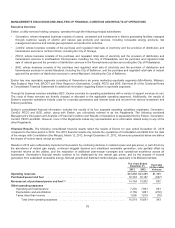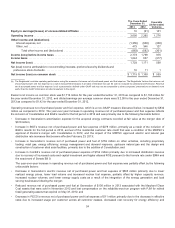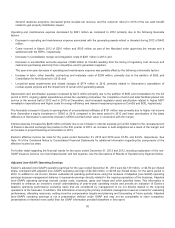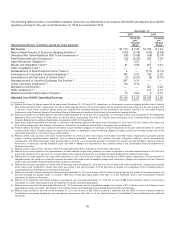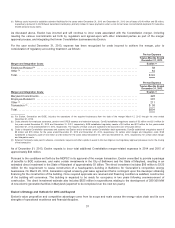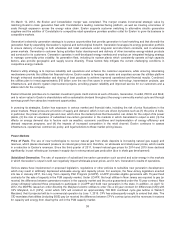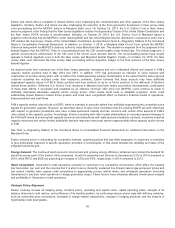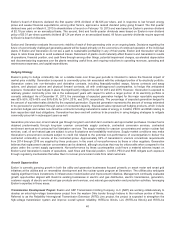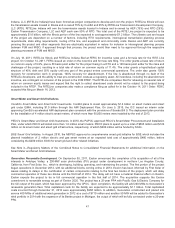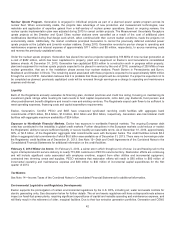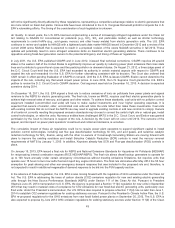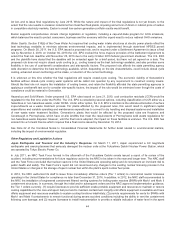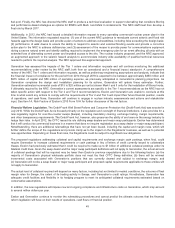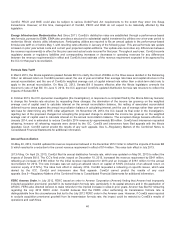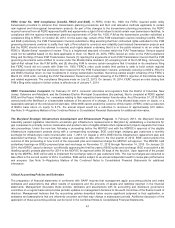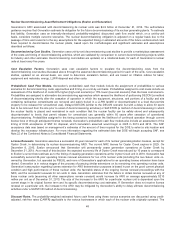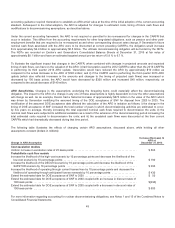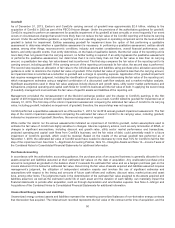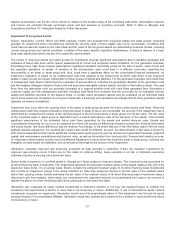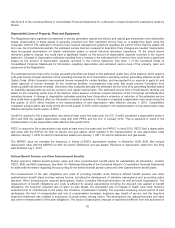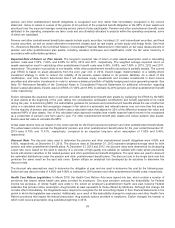ComEd 2013 Annual Report Download - page 49
Download and view the complete annual report
Please find page 49 of the 2013 ComEd annual report below. You can navigate through the pages in the report by either clicking on the pages listed below, or by using the keyword search tool below to find specific information within the annual report.will not besignificantlydirectlyaffectedbytheseregulations, representingacompetitiveadvantage relative to electric generatorsthat
are more reliant on fossil-fuel plants. Variousbillshavebeen introducedintheU.S. Congress that wouldprohibitorimpedetheU.S.
EPA’s rulemakingefforts. Thetimingoftheconsideration ofsuch legislation is unknown.
Air Quality. Inrecent years, theU.S. EPAhasbeen implementingaseriesofincreasinglystringent regulationsunder theClean Air
Act relatingto NAAQS for conventional air pollutants(e.g., NOx,SO
2andparticulate matter)aswell asstricter technology
requirementsto control HAPs (e.g., acid gases, mercuryandother heavy metals) fromelectric generation units. TheU.S. EPA
continuesto reviewandupdate itsNAAQS withatightenedparticulate matter NAAQS issuedinDecember 2012 andareviewofthe
current 2008ozone NAAQS that is expectedto result in a proposedrevision oftheozone NAAQS sometimeinfall 2014. These
updateswill potentiallyresult inmore stringent emissionslimitson fossil-fuel electric generatingstations. There continuesto be
opposition amongfossil-fuel generation ownersto the potential stringency andtimingoftheseairregulations.
InJuly2011,theU.S. EPApublishedCSAPRandinJune 2012,itissuedfinal technical corrections. CSAPRrequires28upwind
statesintheeastern halfoftheUnitedStatesto significantlyimproveairqualitybyreducingpower plant emissionsthat cross state
linesandcontribute to ground-level ozone andfine particle pollution indownwindstates. OnAugust21,2012,athree-judge panel of
theD.C. CircuitCourt heldthat theU.S. EPAhadexceededitsauthorityincertainmaterial aspectswithrespecttoCSAPRand
vacatedthe rule andremandedittotheU.S. EPAfor further rulemakingconsistent withitsdecision.TheCourt alsoorderedthat
CAIRremainineffect pendingfinalization ofCSAPRonremand. UntiltheU.S. EPAre-issuesCSAPR,Exelon cannot determine the
impactsofthe rule,includinganythat wouldimpactpower prices. InJune 2013,theU.S. SupremeCourt grantedtheU.S. EPA’s
petition to reviewtheD.C. CircuitCourt’s CSAPRdecision.Oral argument washeldon December 10,2013.Adecision is expected
sometimeduring2014.
OnDecember 16, 2011,theU.S. EPAsignedafinal rule to reduceemissionsoftoxic air pollutantsfrompower plantsand signed
revisionsto theNSPS for electric generatingunits. Thefinal rule,knownasMATS, requirescoal-firedelectric generation plantsto
achievehigh removal ratesofmercury, acid gasesandother metals. Toachievethesestandards, coal unitswithno pollution control
equipment installed(uncontrolledcoal units) will havetomakecapital investmentsandincur higher operatingexpenses. Itis
expectedthat ownersofsmaller,older,uncontrolledcoal unitswill retire theunitsrather than maketheseinvestments. Coal units
withexistingcontrolsthat do not meet theMATS rule mayneedto upgradeexistingcontrolsor add newcontrolsto comply. Owners
ofoilunitsnot currentlymeetingthe proposedemission standards maychoosetoconvert theunitsto lightoilsor natural gas, install
control technologies, or retire theunits. NumerousentitieshavechallengedMATS intheD.C. CircuitCourt,andExelon wasgranted
permission by theCourt to intervene insupport ofthe rule.Adecision by theCourt will not occur until 2014. The outcomeofthe
appeal,anditsimpactonpower plant operators’ investment andretirement decisions, is uncertain.
Thecumulativeimpactoftheseairregulationscouldbetorequire power plant operatorsto expend significant capital to install
pollution control technologies, includingwet flue gasdesulfurization technology for SO2andacid gases, andselectivecatalytic
reduction technology for NOx.Exelon,alongwiththeother co-ownersofConemaugh GeneratingStation are movingforwardwith
plansto improvetheexistingscrubbersandinstall SelectiveCatalytic Reduction (SCR)controlsto meet themercuryremoval
requirementsofMATS by January1,2015. Inaddition,Keystone already hasSCRandFlue-gasdesulfurization (FGD) controlsin
place.
OnJanuary15, 2013,EPAissuedafinal rule for NSPS andNational EmissionsStandards for HazardousAirPollutants (NESHAP)
for reciprocatinginternal combustion engines(RICE NESHAP/NSPS). Thefinal rule allows diesel backup generatorsto operate for
up to 100 hoursannuallyunder certainemergency circumstanceswithout meetingemissionslimitations, but requiresunitsthat
operate over 15hoursto burn lowsulfur fuel andreport keyengine information.Thefinal rule eliminatesafter May2014the50hour
exemption for peakshavingandother non-emergency demandresponsethat wasincludedinthe proposedrule and, therefore,is
not expectedto result inadditional megawattsofdemandresponsetobebid into thePJM capacityauction.
IntheabsenceofFederal legislation,theU.S. EPAis alsomovingforwardwiththeregulation of GHG emissionsunder theClean Air
Act.TheU.S. EPAis addressingtheissue ofcarbon dioxide(CO2)emissionsregulation for newandexistingelectric generating
unitsthrough theNewSourcePerformanceStandards (NSPS) under Section 111 oftheClean AirAct.Pursuant to President
Obama’s June 25, 2013 memorandumto U.S. EPA,theAgency re-proposedaSection 111(b) regulation for newunitsinSeptember
2013 that mayresult inmaterial costsofcompliancefor CO2emissionsfor newfossil-fuel electric generatingunits, particularlycoal-
firedunits. Under thePresident’s memorandum, theU.S. EPAis alsorequiredto proposeaSection 111(d) rule no later than June 1,
2014to establish CO2emission regulationsfor existingstationarysources. Pursuant to thePresident’s Climate Action Plan,theU.S.
EPAre-proposedregulationsfor theGHG emissionsfromnewfossilfueledpower plantson September 20,2013.TheU.S. EPAis
alsoexpectedto proposeby June 2014 GHG emission regulationsfor existingstationarysourcesunder Section 111(d) oftheClean
43


